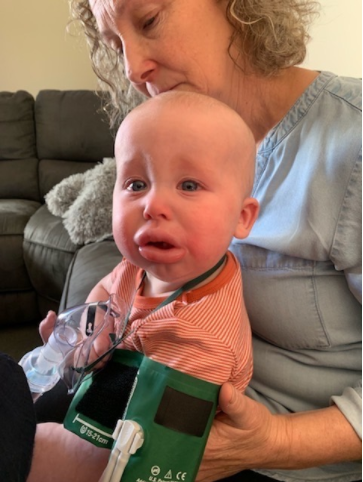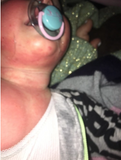

What Anaphylaxis Looks Like
Approximately 1 in 100 of all school-aged children will develop anaphylaxis.
In the past ten years, food-triggered anaphylaxis has doubled, and over the past 20 years, hospital admissions for anaphylaxis have increased by 400%. Despite death from anaphylaxis being relatively rare, Australia has one of the highest fatality rates to other developed countries around the world.
Below you'll hear from 4 different Mamas whose children experienced moderate to severe reactions and what they looked like.



This reaction happened to my son just days after his 1st birthday. I made him an avocado and hummus sandwich, and he reacted to the sesame (tahini) in the hummus. It was perhaps 1/2 teaspoon of hummus containing 17% tahini so as much sesame as maybe 3-4 seeds worth.
Initially, white hives appeared on his body, and I rang 000. By the time the ambulance arrived, he had no signs of the hives anymore and had totally clear skin minus a little scratching. We went to the hospital just for monitoring, and within an hour of being at the hospital, these hives appeared on his body, some as large as 50c coins, all from such a small amount of sesame
We did allergy testing, which resulted in a 9mm hive from the prick test, and it has been classed as a moderate reaction as it didn't affect his breathing. We have been lucky enough to avoid any other reactions as we have entirely removed sesame from home.
Trigger: Peanuts






Halle had her first severe reaction at nine months.
It was cross-contamination of a butter knife and peanut butter. She had previously tried peanut butter - the first and second time, she didn't have any symptoms to be concerned about (maybe a little rash around her face that could have been passed off as teething rash). This particular time I had buttered my toast with peanut butter and hers with just butter and didn't clean the knife in between.
She now has annual allergy testing and has an anaphylaxis care plan and an EpiPen. We have just had her second skin prick test, and her peanut allergy result is higher, then it was 12 months ago. First measured 4mm now measuring 6mm. She is anaphylactic to touch and taste. Daycare is scary as so many parents still give their children peanut butter for breakfast and don't properly clean them or change their clothes. Halle only has to touch something that has traces of peanuts briefly, and she is likely to have a severe reaction.


At nine months old Kohen had a taste of hummus on a rice cake. His only known allergies were milk and egg, so I assumed I was passing him an utterly safe food to try. Instantly he started to cough. I picked him up out of his high chair, and then he vomited, I turned him around to wipe his face and noticed his lips looked slightly swollen. My heart sunk; I knew it was the start of an allergic reaction (but not like any reaction I had dealt with before, there was no itchy hives).
Immediately I called triple zero. I said, "I think my baby's lips are swelling, no they're definitely swelling, they're swelling by the second, they're getting bigger and bigger".
He was completely silent by this stage, not coughing, just staring at me with fear in his eyes. The person on the other end of the phone directed to me give him Zyrtec as stated on his allergy plan while I waited for paramedics to arrive, but he couldn't swallow.
Seven minutes later, four absolutely amazing paramedics arrived. Minutes felt like hours waiting for them to arrive. But I thank my lucky stars every day for how incredible they were. They were quick to put Kohen on oxygen and administer adrenaline. But Kohen didn't respond to the adrenaline like excepted. It all became a bit of a blur from here on, but I remember sentences like "the stridor is spreading" "he needs more adrenaline" they gave him another dose and put more through his nebulizer too. They worked together and saved my babies life. ❤️
These photos are of what a mild to moderate looks like for Kohen.




Trigger: Dairy
Note: There is no story as such with this, but mama Jade wanted to share what a severe reaction looks like in her son.






Before you begin introducing potentially allergenic foods to your little one, PLEASE make sure you have done a first aid course. Like baby Kohen, anaphylaxis can happen quickly and if not treated, can be deadly.
In our course will educate on how to introduce the foods, recap on the signs to look out for and tell you what to do if they react (and you don't have an EpiPen).
Click here to check out our online and face-to-face options.
To the extent permitted by law, Tiny Hearts excludes any liability, including any liability for negligence, for any loss, including indirect or consequential damages arising from or in relation to the use of this blog content.
This blog may include material from third party authors or suppliers. Tiny Hearts is not responsible for examining or evaluating the content or accuracy of the third-party material and it does not warrant and, to the fullest extent permitted by law, will not have any liability or responsibility for any third-party material. This blog was written for informational purposes only and is not a substitute for professional medical advice. Nothing contained in this blog should be construed as medical advice or diagnosis.The content on our blog should not be interpreted as a substitute for physician consultation, evaluation, or treatment. Do not disregard the advice of a medical professional or delay seeking attention based on the content of this blog. If you believe someone needs medical assistance, do not delay seeking it. In case of emergency, contact your doctor, visit the nearest emergency department, or call Triple Zero (000) immediately.
The author of this information has made a considerable effort to ensure the information is in-line with current guidelines, codes and accepted clinical evidence at time of writing, is up-to-date at time of publication and relevant to Australian readers.
